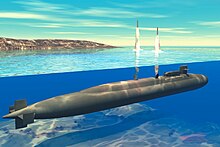Ohio class
The Ohio class is a type of submarine, also called Trident submarines, belonging to the United States Navy. They have nuclear propulsion and ballistic missiles. Its armament consists of 24 Trident II ballistic missiles with a range of 12,000 km each. It also has four 533 mm torpedo tubes in the bow. The United States has 18 submarines of this class: 14 strategic submarines armed with 24 Trident II SLBMs; and 4 cruise missile submarines, armed with 154 conventionally tipped BGM-109 Tomahawk cruise missiles.
The 14 Ohio class submarines represent about 50% of the total US nuclear inventory. Due to the treaties, the nuclear warheads of the submarines do not have a pre-established target when they are on patrol, but they are capable of redirecting them quickly since they have a continuous communication channel with the base. The Ohio Class is the largest submarine built by the United States Navy, and are the largest submarines after the Russian Navy's Borei, Delta IV, and Project 941 Akula (Typhoon) submarines.
The Ohio class was designed primarily to conduct deterrence patrols. Each submarine has 2 crews, Blue and Gold, each serving at 100-day intervals. They have plenty of space for food, equipment and spare parts to maximize time on patrol, their nuclear reactor can last 15 years without recharging. It is very quiet at the speed of 20 knots.n
Conversion to SSGN


After the end of the Cold War, the USS Ohio and 3 others of this class were planned to be retired by 2002. However, it was decided to modify the Ohio, USS Michigan, USS Florida and USS Georgia so that they could carry guided missiles, being then redesignated as a ballistic missile submarine or SSGN.

The project began in 2002 and will end in 2010, 22 of the 24 2.2 m diameter tubes used for the Trident missiles were modified to contain large vertical launch systems, one such configuration may be a group of seven Tomahawk cruise missiles. In this configuration, the number of cruise missiles that can be carried is a maximum of 154 units, similar to the number deployed in a surface battle group. Other possible configurations include carrying a new generation of supersonic and hypersonic cruise missiles, and submerged-launched intermediate-range ballistic missiles, Unmanned Aerial Vehicle (UAV), the ADM-160 MALD decoy missile, sensors for anti-submarine warfare or intelligence, sensors for surveillance and reconnaissance missions, mine warfare systems, such as the AN/BLQ-11 Long Term Mine Reconnaissance System (LMRS)), and specialized cargo containers such as the Broaching Universal Buoyant Launcher (BUBL) and the Affordable Stealth Capsule System.

The missile tubes also have space to store containers that can increase the duration of forward deployments for special forces. The other two remaining Trident tubes were converted to airtight chambers to allow surface exits for divers. For special operations, the SEAL Advanced Deployment System or the Dry Deck Shelter can be mounted on the submarine's airlock and the ship can carry up to 66 special operations sailors or marines, such as SEAL teams from the Navy. Navy or MARSOC of the Marines. Improved communications equipment installed during the upgrades allows the SSGN to serve as a Joint Small Combat Unit Command Center.
The contract to upgrade these boats was awarded to GD Electric Boat at a cost of $442.9 million. The first submarine to be successfully converted was the Ohio, which left dry dock on January 9, 2006. These submarines are expected to be in service until 2023-2026.
Submarines
| Name | Tip in gravel | Boot | Incorporation |
|---|---|---|---|
| USS Ohio (SSGN-726) | 10 April 1976 | 7 April 1979 | 11 November 1981 |
| USS Michigan (SSGN-727) | 4 April 1977 | 26 April 1980 | 11 September 1982 |
| USS Florida (SSGN-728) | 4 July 1976 | 14 November 1981 | 18 June 1983 |
| USS Georgia (SSGN-729) | 7 April 1979 | 6 November 1982 | 11 February 1984 |
| USS Henry M. Jackson (SSBN-730) | 19 January 1981 | 15 October 1983 | 6 October 1984 |
| USS Alabama (SSBN-731) | 14 October 1980 | 19 May 1984 | 25 May 1985 |
| USS Alaska (SSBN-732) | 9 March 1983 | 12 January 1985 | 25 January 1986 |
| USS Nevada (SSBN-733) | 8 August 1983 | 14 September 1985 | 16 August 1986 |
| USS Tennessee (SSBN-734) | 9 June 1984 | 13 December 1986 | 17 December 1988 |
| USS Pennsylvania (SSBN-735) | 10 January 1984 | 23 April 1988 | 9 September 1989 |
| USS West Virginia (SSBN-736) | 24 October 1987 | 14 October 1989 | 20 October 1990 |
| USS Kentucky (SSBN-737) | 18 December 1987 | 11 August 1990 | 13 July 1991 |
| USS Maryland (SSBN-738) | 22 April 1986 | 15 June 1991 | 13 June 1992 |
| USS Nebraska (SSBN-739) | 6 July 1987 | 15 August 1992 | 10 July 1993 |
| USS Rhode Island (SSBN-740) | 15 September 1988 | 17 July 1993 | 9 July 1994 |
| USS Maine (SSBN-741) | 4 July 1990 | 14 November 1994 | 18 June 1995 |
| USS Wyoming (SSBN-742) | 8 August 1991 | 15 July 1995 | 13 July 1996 |
| USS Louisiana (SSBN-743) | 23 October 1992 | 27 July 1996 | 6 September 1997 |